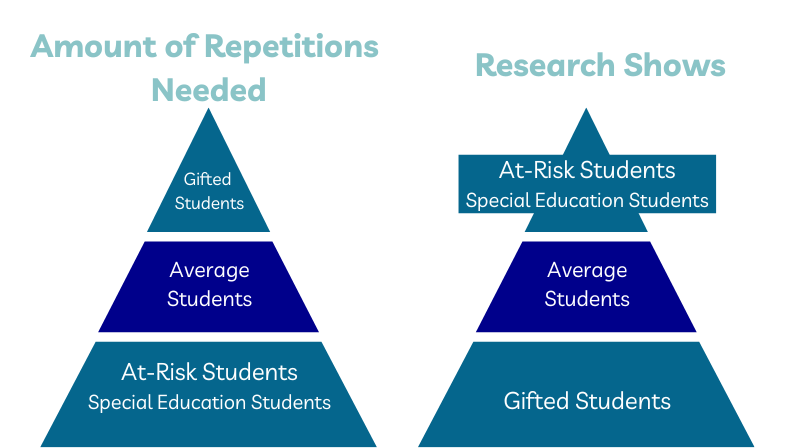Christie Schutz Vincelli, Ed.D.
As a school administrator, one of the key responsibilities is to observe teachers within the classroom and to provide feedback. As part of these observations, we tend to focus on the classroom environment, lesson preparation, behavior management, assessment and teacher professional responsibilities. Take a moment to think about an observation that you conducted this year and reflect on the following:
- How much of your observation focused on the teacher and what s/he was doing? How much of it focused on student behavior?
- Did you focus on active student responding (ASR) or how many students responded throughout the time period observing?
- If I asked you how many of the students in the classroom had an opportunity to participate during the lesson observed and how frequently, would you be able to answer?
- How do you define student participation?
During behavioral RTI consultations, some of the most frequently asked questions are about disruptive behavior. Teachers want to know how to prevent calling out, work refusal, the inability to attend to the teacher, or a student constantly being out of his/her seat. They want to know how to address those behaviors with interventions at tier 2 or 3. The secret that I am going to share with you is that 85% of the “behavior” problems named above can be easily resolved by simple changes in the teacher’s behavior. These challenges are actually issues within tier 1 that if appropriately addressed, will increase the student’s ability to be successful.
During a one-on-one consultation, I ask the administrator if I can observe the student presenting with the concerns in class. It is very common for students to exhibit problem behaviors in one classroom setting and not another, though this may be more difficult to isolate at the elementary level due to the one classroom model. Once in the classroom environment, I observe the student and count how many times s/he is actively participating. ASR is defined by an observable and measurable behavior that can be recorded by a basic count, tally or frequency of responses between teacher and student. The more a student responds, the more likely s/he is to remain actively engaged, and this will increase attending or on-task behavior. Conversely, the less the student remains actively engaged, the more likely s/he is to engage in these problem behaviors.
In a typical classroom environment, a teacher has students raise their hands to answer questions. However, when only one student is called upon, the others are not actively engaged. Additionally, when teachers ask questions such as, “Does anyone know the answer to 2+2?” it encourages students who know the answer to respond. The student of concern may be inattentive or may not understand the concept, which leads them to a lower rate of participation. It also increases the likelihood of problem behavior.
Figure 1
Figure 1 provides a visual summary of the research on teachers who ask a question and the students raise their hands to respond. The graph on the left is the model teachers should follow when it comes to the amount of ASRs needed by the “at-risk group.” The graph on the right shows what teachers typically do in the classroom. So, what can we do differently in tier 1 and how can we adapt teaching practices to increase ASR?
- Observe the student within the classroom and change your focus from the teacher to the student. Take an active count of how often the student engages in an ASR. If the student is minimally engaged or not engaged at all, chances are that new classroom-based strategies need to be implemented to increase ASR.
- Provide professional development to teachers at the tier 1 level on group ASR strategies and work to decrease the use of the traditional one question, one answer model. What are you doing to ensure other students are engaged or understand the objective in a one question, one answer model? Use research-based ASR strategies that engage all students in responding. Research shows that the most effective ASR strategy is providing each student with a dry erase board to share their answers. For example, if the teacher asks, “What is 2+2?”, each student has the opportunity to respond, allowing the teacher to quickly assess the students’ knowledge. Response cards and choral responding have also proven to be effective strategies to increase classroom-based ASR.
- Challenge teachers to count how many times each student in the class has an opportunity to actively participate while in small and large group settings. Then teachers can target increasing ASR via an action research project or a goal for a professional growth plan.
- Shift your practice for teacher observation. Look for research-based instructional strategies that decrease problem behavior increase student learning, and keep students engaged. Count how many times each student has engaged in ASR during your observation. You can do this by using a simple tally.
Finally, I leave you with this final thought. If you place students presenting with challenging behaviors in a smaller group, why are they more successful? In a small group or pairing, the amount of ASR triples and the student has no choice but to be engaged in positive and proactive classroom-based instruction. Reforming classroom-based instruction at the tier 1 level will not only yield success behaviorally, but academically as well.
As you begin to implement your district’s RTI or multi-tiered system of support (MTSS), the Magnolia Consulting Group can help. Have you conducted a gap analysis of your tier 1 supports? With our resources and experience in RTI implementation, we can conduct your gap analysis and help you create a tier 1 implementation plan to provide the necessary support for students to be successful in general education programs. Contact us at [email protected]!


